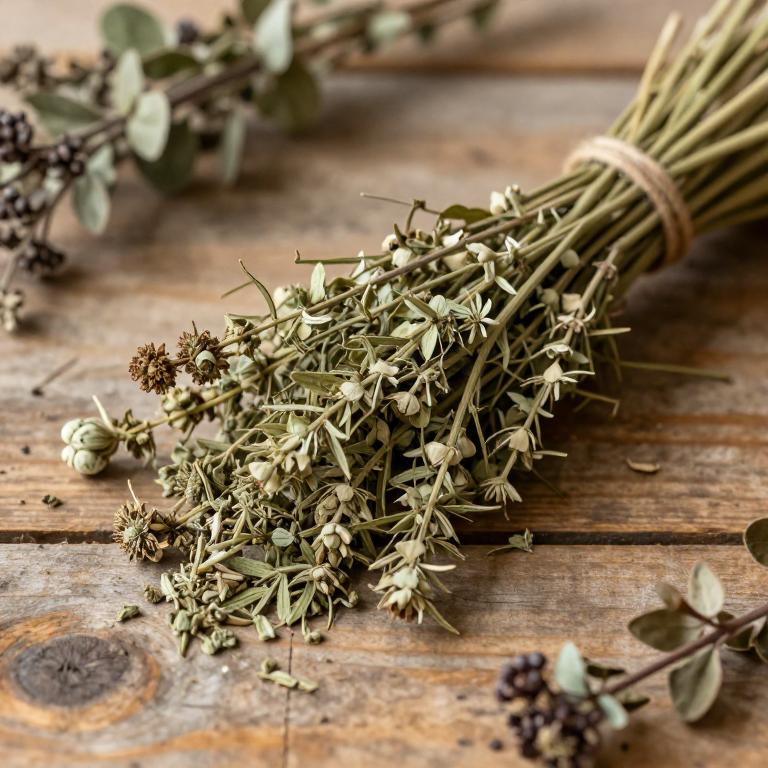Velvetleaf (Verbascum Thapsus)
Information Reliability Score: 5/10
This score reflects the overall reliability of the information presented in this article. It is based on the quality of scientific evidence, accuracy of sources, and the transparency of references related to Verbascum thapsus.

Common Mullein, scientifically known as Verbascum thapsus, is a biennial herb native to Europe, Asia, and North Africa, often found in disturbed soils and along roadsides.
It is widely recognized as a medicinal herb, valued for its adaptogenic properties and historical use in traditional medicine. The plant's primary benefits include its ability to support respiratory health, reduce inflammation, and soothe coughs, making it a popular remedy for respiratory ailments. Historically, it has been used by Native American tribes and European herbalists to treat lung conditions, while modern wellness practices continue to incorporate it as a natural remedy for bronchitis and asthma.
One of its unique features is its distinctive velvety leaves and its historical association with healing, particularly in folk medicine.
FREE CHECKLIST
The Only 10 Herbs You Need to Heal 90% of Common Ailments.

Table of Contents
Scientific and Botanical Profile
Common Mullein, with botanical name Verbascum thapsus, is a biennial or short-lived perennial plant belonging to the family Scrophulariaceae.
It is widely known by common names such as Velvetleaf, Goatweed, and Thapsus Mullein, reflecting its widespread presence and historical uses. Native to regions including Europe, Asia, North Africa, the Middle East, Central Asia, and parts of Southern and Eastern Europe, it has also naturalized in Northern Africa, Southwest Asia, the Balkan Peninsula, and the Caucasus Region. Morphologically, Common Mullein is characterized by its tall, erect stems covered in dense, velvety gray-green hairs, with large, lance-shaped leaves that are also hairy.
It produces showy yellow-orange flowers in clusters, which bloom in late summer, making it a notable wildflower in various ecological settings.
History and Cultural Relevance
Common Mullein was used by ancient civilizations such as the Greeks, Romans, and Native American tribes for its medicinal and practical properties.
In traditional medicine, its leaves and flowers were employed to treat respiratory ailments, including coughs, bronchitis, and asthma, due to their expectorant and anti-inflammatory qualities. The plant also held cultural significance, with some indigenous communities using it in ceremonial rituals to promote healing and spiritual connection. In folk traditions, mullein was often burned as a source of light in lanterns or used in herbal remedies to soothe inflammation and support lung health.
Today, its traditional uses continue to influence modern herbal practices, with mullein still valued as a natural remedy for respiratory conditions and skin irritations.
Chemical Composition and Nutritional Profile
Common Mullein contains a variety of bioactive compounds, including alkaloids, flavonoids, essential oils, and terpenes, which contribute to its medicinal properties.
It is rich in antioxidants such as quercetin and rutin, which help neutralize free radicals and support immune function. The plant also provides essential nutrients like vitamins A, C, and E, along with minerals such as potassium and magnesium, offering a broad spectrum of health benefits. These compounds work synergistically to reduce inflammation, soothe respiratory conditions, and exhibit antimicrobial effects.
Overall, its chemical composition and nutritional profile make Common Mullein a valuable herb in traditional and complementary medicine.
Medicinal Properties and Health Benefits
Verbascum thapsus has been traditionally used for its anti-inflammatory, antimicrobial, and antioxidant properties, making it beneficial for supporting the immune system and reducing inflammation in the respiratory and digestive systems.
It is particularly effective in alleviating symptoms of respiratory conditions such as bronchitis and asthma due to its ability to loosen mucus and reduce airway inflammation. Compared to similar herbs like echinacea or thyme, verbascum thapsus offers a broader spectrum of bioactive compounds, including flavonoids and mucilage, which enhance its soothing and healing effects. Its mucilage content makes it more potent for coating and protecting the mucous membranes, providing relief for conditions like sore throat and gastrointestinal irritation.
While it shares some benefits with other demulcent herbs, verbascum thapsus stands out for its unique combination of mild sedative and expectorant properties, making it a versatile choice for holistic health support.
Discover the 10 best health benefits of Velvetleaf.
Forms, Preparation and Usage
Verbascum thapsus has been traditionally used for its medicinal properties, and it is available in various forms including fresh leaves, dried tincture, powder, essential oil, and capsules.
To prepare it, it can be made into a tea by steeping dried leaves in hot water, or a decoction can be made by boiling the plant parts for a longer period. It can also be used as an infusion or applied topically for skin conditions. The recommended dosage for adults is typically 1 to 3 grams of dried herb per day, while children should only use it if deemed safe by a healthcare professional.
Due to the potential for side effects and lack of standardized dosing, it is advised to use Verbascum thapsus sparingly and for short durations, ideally under medical supervision.
Safety, Side Effects and Contraindications
Verbascum thapsus can be used as a medicinal plant for its potential anti-inflammatory and antimicrobial properties, but it should be approached with caution due to its potential side effects and interactions.
It may cause gastrointestinal discomfort, allergic reactions, and skin irritation in some individuals. Due to limited research, it is important to consult a healthcare professional before use, especially for those with pre-existing conditions or taking other medications. Pregnant and breastfeeding women should avoid it due to possible harm to the fetus or infant, and it is contraindicated in individuals with chronic illnesses without medical supervision.
To ensure safety, always use verbascum thapsus under professional guidance, follow recommended dosages, and monitor for adverse reactions.
Growing, Harvesting and Storage
Verbascum thapsus grows best in well-drained, loamy soil with a slightly alkaline pH, in full sun to partial shade, and requires moderate watering to avoid waterlogging.
It thrives in temperate climates and is relatively low maintenance, needing occasional weeding and pruning to promote bushy growth and prevent disease. The best time to harvest Verbascum thapsus is during late summer to early autumn when the leaves are fully mature and the plant has accumulated the highest concentration of medicinal compounds. Harvesting should be done by cutting the entire plant at the base with sharp scissors or shears to ensure minimal damage and maximum yield.
After harvesting, the plant should be dried in a cool, dark, well-ventilated area to preserve its potency, and stored in airtight containers away from moisture and direct sunlight.